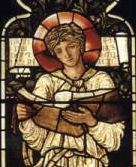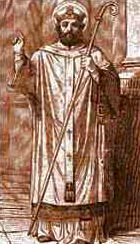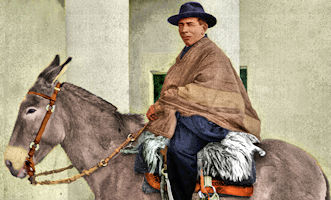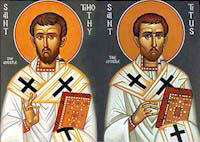Ordinary Time: January 26th
Memorial of Sts. Timothy and Titus, bishops
Old Calendar: St. Polycarp, bishop and martyr; Bl. José Gabriel Brochero (new)
St. Timothy, born in Galatia in Asia Minor, was baptized and later ordained to the priesthood by St. Paul. The young Galatian became Paul's missionary companion and his most beloved spiritual son. St. Paul showed his trust in this disciple by consecrating him bishop of the great city of Ephesus. St. Timothy was stoned to death thirty years after St. Paul's martyrdom for having denounced the worship of the goddess Diana. According to the 1962 Missal of St. John XXIII the Extraordinary Form of the Roman Rite St. Timothy's feast is celebrated on January 24 and the feast of St. Titus is on February 6.
St. Titus, a convert from paganism, was a fellow laborer of St. Paul on many apostolic missions. St. Paul later made him bishop of Crete, a difficult charge because of the character of the inhabitants and the spread of erroneous doctrines on that island. St. Paul's writings tell us that St. Titus rejoiced to discover what was good in others and drew the hearts of men by his wide and affectionate sympathy.
According to the 1962 Missal of St. John XXIII, today is the feast of St. Polycarp, which is now celebrated in the Ordinary Form of the Roman Rite on February 23.
St. Timothy Timothy was Paul's dearest disciple, his most steadfast associate. He was converted during the apostle's first missionary journey. When Paul revisited Lystra, Timothy, though still very young (about twenty) joined him as a co-worker and companion. Thereafter, there existed between them a most intimate bond, as between father and son. St. Paul calls him his beloved child, devoted to him "like a son to his father" (Phil. 2:22). Of a kindly disposition, unselfish, prudent, zealous, he was a great consolation to Paul, particularly in the sufferings of his later years. He also assisted the apostle in the establishment of all the major Christian communities and was entrusted with missions of highest importance. Timothy was with Paul during his first Roman imprisonment. Paul made his self-sacrificing companion bishop of Ephesus, but the finest monument left him by his master are the two canonical Epistles bearing his name.
Timothy was Paul's dearest disciple, his most steadfast associate. He was converted during the apostle's first missionary journey. When Paul revisited Lystra, Timothy, though still very young (about twenty) joined him as a co-worker and companion. Thereafter, there existed between them a most intimate bond, as between father and son. St. Paul calls him his beloved child, devoted to him "like a son to his father" (Phil. 2:22). Of a kindly disposition, unselfish, prudent, zealous, he was a great consolation to Paul, particularly in the sufferings of his later years. He also assisted the apostle in the establishment of all the major Christian communities and was entrusted with missions of highest importance. Timothy was with Paul during his first Roman imprisonment. Paul made his self-sacrificing companion bishop of Ephesus, but the finest monument left him by his master are the two canonical Epistles bearing his name.
— Excerpted from The Church's Year of Grace, Pius Parsch
Patron: Intestinal disorders; stomach diseases.
Symbols: Club and stones; broken image of Diana.
Things to Do:
- No one understood the heart of St. Paul better than St. Timothy. His finest legacy is the two epistles he wrote to Timothy. Today would be an opportune occasion to study these epistles and to apply personally the high ideals proposed.
- Look up the descriptions St. Paul gives of his traveling companion, Tim: 1, Cor. 4:17, Phil. 2:19-20, Rom. 16:21, and 2 Tim. 1:4-5.
- Pray that the Church may be blessed with bishops, priests, and deacons, endowed with all those qualifications St. Paul requires from the dispensers of the mysteries of God. Say the following invocation frequently: "Jesus, Savior of the world, sanctify Thy priests and sacred ministers."
St. Titus St. Titus, a pagan by birth, became one of St. Paul's most illustrious disciples. He accompanied the apostle on several of his missionary journeys and was entrusted with important missions. Finally he came with St. Paul to the island of Crete, where he was appointed bishop. He performed this duty in accordance with the admonition given him, ". . . in all things show yourself an example of good works" (Tit. 2:7).
St. Titus, a pagan by birth, became one of St. Paul's most illustrious disciples. He accompanied the apostle on several of his missionary journeys and was entrusted with important missions. Finally he came with St. Paul to the island of Crete, where he was appointed bishop. He performed this duty in accordance with the admonition given him, ". . . in all things show yourself an example of good works" (Tit. 2:7).
Tradition tells us that he died a natural death at the age of 94, having lived in the state of virginity during his whole life. St. Paul left a worthy monument to Titus, his faithful disciple, in the beautiful pastoral letter which forms part of the New Testament. Today's feast in his honor was introduced in 1854.
— Excerpted from The Church's Year of Grace, Pius Parsch
Patron: Crete.
Symbols: Broken images; ruined temple of Jupiter.
Things to Do:
- St. Paul left a worthy monument to Titus, his faithful disciple, in his letter. Read this letter.
- Even though St. Timothy and Titus were disciples, bake some apostle cookies and adapt them for this feast.
Bl. José Gabriel Brochero Blessed José Gabriel is known in Argentina as the “cowboy priest.” This gaucho, as local cattle-herders are known, served a large parish spread over miles of mountainous terrain.
Blessed José Gabriel is known in Argentina as the “cowboy priest.” This gaucho, as local cattle-herders are known, served a large parish spread over miles of mountainous terrain.
Bl. José showed bravery in his first years as a priest by ministering to victims of a cholera epidemic in the city of Cordoba, Argentina. At 29 he was assigned to St. Albert, a remote parish numbering about ten thousand souls with neither schools nor roads. Padre José went on the back of a mule along the mountains to care for his flock, carrying a Mass kit and an image of the Blessed Mother. His flock was, in a sense, “lost,” so remote were they from the larger society. Father José said of his people that “they were abandoned by everyone, but not by God.” Early in his tenure, he desired spiritual renewal for his parish and so he led a group across mountains in a snowstorm to a retreat being held at Cordoba on the Spiritual Exercises of St. Ignatius. This beginning in prayer produced much fruit in the parish.
His priestly ministry drew him to the people, to “go out,” as Jesus and his apostles went out to where the people were to be found. This “going out” involved risk: the danger of terrain, long days far from home, and the unexpected. Pope Francis has especially encouraged priests and generally all Christians to get out on the roads and into the public squares as a necessary first step in evangelization, in sharing Christ.
Blessed José Gabriel was not unknown to the public for his incarnational way of ministering. He worked alongside his people. A Cordoba newspaper wrote about this priest’s way of serving in an 1887 article:
"He practices the gospel. Are you missing a carpenter? He’s a carpenter. Are you missing a laborer? He’s a laborer. He rolls up his cassock wherever he is, takes the shovel or hoe and opens a public road in 15 days aided by his parishioners."
In these tasks Bl. José found a space of communion in labor with his parishioners and a solid imitation of his patron, St. Joseph. He worked to build roads, schools, and to get mail and telegraph couriers for the good of the people. In his letter to those gathered for the beatification ceremony, Pope Francis said: “This shepherd who smelled of sheep became poor among the poor.”
Bl. José Gabriel was born in 1840, the same year of birth as St. Damien of Molokai. Like Damien, José Gabriel served those who were considered untouchable, the lepers, and like Damien he died a leper. He continued to pray and offer Mass although ill and blind. His “going out” was a complete emptying of self. Pope Francis wrote: “Brochero did not stay in the parish offices: he would exhaust himself riding his mule and he ended up being sick with leprosy.” Bl. José Gabriel died January 26, 1914.
The beatification ceremony at Cordoba was attended by close to 150,000 people, including three thousand gauchos wearing the traditional ponchos of the Argentine cowboy. This priest was a lone ranger when he had to be and, like his Divine Master, was brave, courageous, and bold.
Excerpted from Dominican Friars | Province of St. Joseph
Things to Do:
